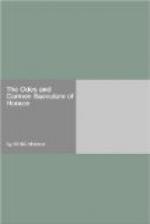In the case of one of the three poems written by Horace
in the measure called the greater Asclepiad, ("Tu ne
quoesieris,”) I have adopted the couplet; in
another ("Nullam, Vare,”) the quatrain, the
determining reason in the two cases being the length
of the two Odes, the former of which consists but of
eight lines, the latter of sixteen. The metre
which I selected for each is the thirteen-syllable
trochaic of “Locksley Hall;” and it is
curious to observe the different effect of the metre
according as it is written in two lines or in four.
In the “Locksley Hall” couplet its movement
is undoubtedly trochaic; but when it is expanded into
a quatrain, as in Mrs. Browning’s poem of “Lady
Geraldine’s Courtship,” the movement changes,
and instead of a more or less equal stress on the alternate
syllables, the full ictus is only felt in one syllable
out of every four; in ancient metrical language the
metre becomes Ionic a minore. This very Ionic
a minore is itself, I need not say, the metre of a
single Ode in the Third Book, the “Miserarum
est,” and I have devised a stanza for it, taking
much more pains with the apportionment of the ictus
than in the case of the trochaic quatrain, which is
better able to modulate itself. I have also ventured
to invent a metre for that technically known as the
Fourth Archilochian, the “Solvitur acris hiems,”
by combining the fourteen-syllable with the ten-syllable
iambic in an alternately rhyming stanza. [Footnote:
I may be permitted to mention that Lord Derby, in
a volume of Translations printed privately before
the appearance of this work, has employed the same
measure in rendering the same Ode, the only difference
being that his rhymes are not alternate, but successive.]
The First Archilochian, “Diffugere nives,”
I have represented by a combination of the ten-syllable
with the four-syllable iambic. For the so-called
greater Sapphic, the “Lydia, die per omnes”
I have made another iambic combination, the six-syllable
with the fourteen-syllable, arranged as a couplet.
The choriambic I thought might be exchanged for a
heroic stanza, in which the first line should rhyme
with the fourth, the second with the third, a kind
of “In Memoriam” elongated. Lastly,
I have chosen the heroic quatrain proper, the metre
of Gray’s “Elegy,” for the two Odes
in the First Book written in what is called the Metrum
Alcmanium, “Laudabunt alii,” and “Te
maris et terrae,” rather from a vague notion
of the dignity of the measure than from any distinct
sense of special appropriateness.
From this enumeration, which I fear has been somewhat tedious, it will be seen that I have been guided throughout not by any systematic principles, but by a multitude of minor considerations, some operating more strongly in one case, and some in another. I trust, however, that in all this diversity I shall be found to have kept in view the object on which I have been insisting, a metrical correspondence with the original. Even where I have been most inconsistent, I have still




